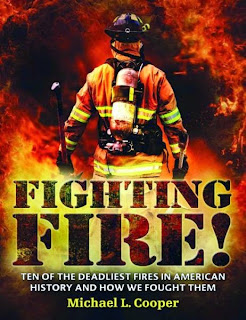In short chapters arranged in chronological order, Cooper provides some historical context, describes how the fire spread and how people attempted to put it out with the equipment of the time. He also explains fire's effects; in some cases, how firefighting improved because of knowledge gained from the fire, while other fires led to broader changes—to the law, to the architecture of a city, and even, perhaps, revolution. "Some historians," Cooper writes, "have wondered if the Great Fire of 1760 [in Boston] added to the greivances that led to the American Revolution." Plentiful black and white illustrations and photographs are included, as well as source notes, a bibliography, and index.
Cooper doesn't mention how he chose the ten fires he focuses on in Fighting Fire. It closes with the San Diego wildfires in 2007, the only wildfire among the ten. But disruptive as it was, it did not match the devastation—or have the long-term impact—of the Big Burn.
 During the dry summer of August 1910, fires began to burn in the forests of Washington, Idaho, and Montana. The U.S. Forest Service, then only five years old, was fighting to establish itself over the furious objections of many, including congressman who tried to de-fund it out of existence. Now the undermanned Forest Service was consumed in another fight, this one against the most destructive fire they had ever seen.
During the dry summer of August 1910, fires began to burn in the forests of Washington, Idaho, and Montana. The U.S. Forest Service, then only five years old, was fighting to establish itself over the furious objections of many, including congressman who tried to de-fund it out of existence. Now the undermanned Forest Service was consumed in another fight, this one against the most destructive fire they had ever seen.But how was the Forest Service established, with foresters so determined to save and protect the land? This, too, is central to the story Timothy Egan tells of how, over the course of a few days, three million acres, including seven towns, burned and 87 people died.
The subtitle of The Big Burn: Teddy Roosevelt and the Fire that Saved America is a bit misleading. But then, Teddy Roosevelt is the one we're familiar with today, the one we still recognize. Gifford Pinchot? I'd never heard of him (maybe since I'm not from Pennsylvania), but as Egan demonstrates, Pinchot was just as essential to the expansion of national parks and protected lands as Roosevelt. Intertwined with Egan's lively account of Roosevelt's and Pinchot's battle for conservation and vivid descriptions of the fire are the stories of some of the brave people who helped to fight the fire.
Fighting Fire!: Ten of the Deadliest Fires in American History and How We Fought Them by Michael L. Cooper
MG/YA nonfiction
Published 2014 by Henry Holt Books for Young Readers (ISBN 9780805097146)
The Big Burn: Teddy Roosevelt and the Fire that Saved America by Timothy Egan
Adult nonfiction
Paperback edition published 2010 by Houghton Mifflin Harcourt (ISBN 9780547394602)


No comments :
Post a Comment